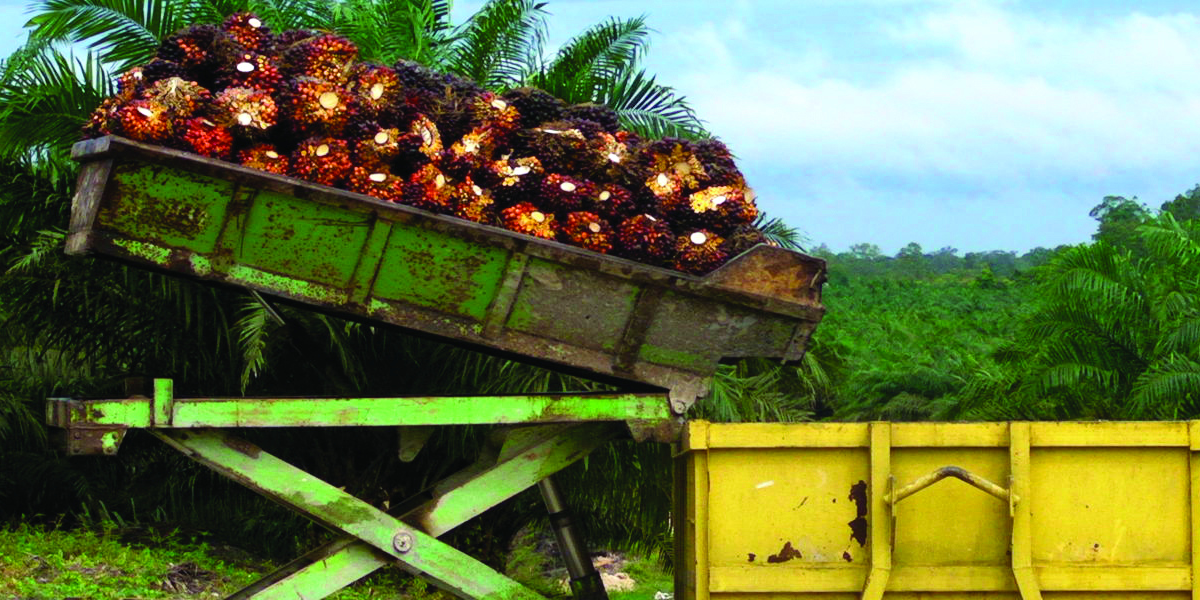Palm oil is a globally traded agricultural commodity that is used in 50 percent of all consumer goods, from lipstick and packaged food to body lotion and biofuels.[1] Used in about half of the products on supermarket shelves, palm oil imports to the U.S. have jumped 485% in the last decade, [2]pushing palm oil cultivation into the rainforests and making this crop one of the key causes of rainforest destruction around the globe.
Approximately 85 percent of palm oil is grown in the tropical countries of Indonesia, Malaysia and Papua New Guinea (PNG) on industrial plantations [3] that have severe impacts on the environment, forest peoples and the climate.
Palm oil destroys rainforests
Indonesia’s tropical rainforests are among the world’s most diverse. They provide critical habitat to species including highly endangered Sumatran tigers, Sumatran elephants and orangutans. The Indonesian government has announced plans to convert approximately 18 million more hectares of rainforests, an area the size of Missouri, into palm oil plantations by 2020.[4]
Palm oil threatens forest peoples
Tens of millions of Indonesians rely directly on rainforests for their livelihoods.[5] A single palm oil plantation can destroy the forests, watersheds, and forest resources of thousands of Indonesians, leaving entire forest communities to face poverty, many for the first time.[6]
Palm oil causes climate change
Rainforests are the earth’s largest sinks of carbon, safely storing the greenhouse gases that cause climate change. In Indonesia, rainforests are razed to create industrial palm oil plantations, releasing massive quantities of carbon dioxide into the atmosphere.[7] In fact, deforestation causes eighty percent of Indonesia’s CO2 emissions, making the tropical nation the world’s third largest emitter of greenhouse gases.[8]
Who is responsible?
North American food and agribusiness companies purchase from, operate, and own many palm oil plantations in Southeast Asia, making our corporations a powerful force in the palm oil market.
The largest privately owned company in the U.S.,[10] Cargill dominates the American palm oil market. They own five palm oil plantations in Indonesia and PNG and are the largest importer of palm oil into the U.S., sourcing from at least 26 producers and buying roughly 11 percent of Indonesia’s total oil palm output.[11] A large and growing number of investigations have shown that Cargill’s palm oil is directly destroying forests, eliminating biodiversity and harming forest peoples.[12]
RAN is actively working to stop the destruction of rainforests due to industrial agribusiness expansion. We encourage companies like Cargill to stop producing, trading and purchasing palm oil that destroys rainforests using grassroots pressure, corporate engagement, and non-violent direct action.
[1] RSPO fact sheet. Promoting the growth and use of sustainable palm oil. 2008. (Accessed at:www.rspo.org/resource_centre/RSPO_Fact_sheets_Basic.pdf on 1/10/10)
[2] “United States Palm Oil Imports by Year (1000 MT),” Index Mundi, (Accessed at: http://www.indexmundi.com/agriculture/?country=us&commodity=palm-oil&graph=imports on 1/13/12)
[3] Malaysian Palm Oil Counsel. Malaysia-Indonesia cooperation to strengthen commodity prices. Press Release 11/6/2008 (Accessed at www.malaysiapalmoil.org/pdf/20081106-malaysia-indonesia.pdf on 1/11/2010).
[4] The Jakarta Post. Indonesia allocates 18 million hectares of land for palm oil. 12/02/2009.
[5] Sunderlin et al. Economic crises, small farmer well-being, and forest cover change in Indonesia. World Development. April, 2001.
[6] See, for example, CIFOR’s The impact and opportunities of palm oil in SE Asia(http://www.cifor.cgiar.org/Knowledge/Publications/Detail?pid=2792) Friends of the Earth’s The Kalimantan Border Oil Palm Mega Project(www.foe.co.uk/resource/reports/palm_oil_mega_project.pdf), and Greenpeace’s How the palm oil industry is cooking the climate(http://www.greenpeace.org/raw/content/international/press/reports/palm-o…).
[7] Sheil, D. et al. The impacts and opportunities of oil palm in Southeast Asia: What do we know and what do we need to know? Occasional paper no. 51. CIFOR, Bogor, Indonesia. 2009.
[8] The Independent. Deforestation: The hidden cause of global warming. 5/14/2007 (Accessed at: www.independent.co.uk/environment/climate-change/deforestation-the-hidden-cause-of-global-warming-448734.html on 12/05/09).
[9] General Mills. Corporate Social Responsibility Report. 2009 (Accessed atwww.generalmills.com/corporate/commitment/corp.aspx on 12/12/09).
[10] Forbes. America’s largest private companies. 10/28/09. (Accessed atwww.forbes.com/2009/10/28/largest-private-companies-business-private-companies-09_land.html on 10/30/09).
[11] J. W.V. Gelder, Greasy Palms: European Buyers of Indonesian Palm Oil. Friends of the Earth, 2004.
[12] See for example, Rainforest Action Network’s Legacy of Destruction (http://ran.org/fileadmin/materials/comms/mediacontent/reports/Case_Study…) Commodity Colonialism (http://ran.org/fileadmin/materials/comms/mediacontent/reports/Case_Study…),
